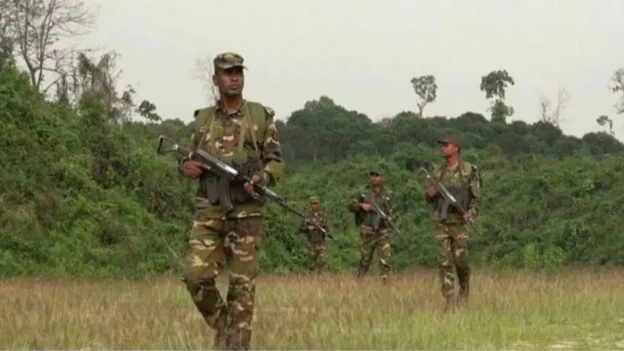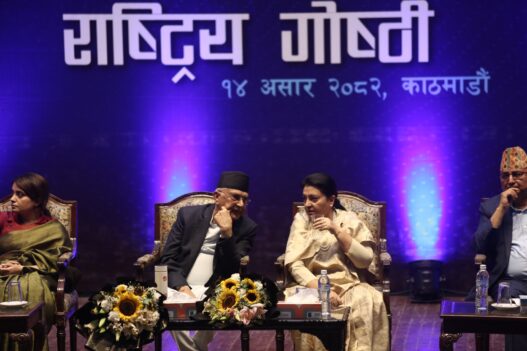The recent outbreak of violence in Manipur has opened a pandora box of possibilities. In a dynamic and fluidic space which the Zo people (Zomi-Kuki-Hmar-Mizo) occupy, where kinship and familial ties cut across several state territorial boundaries, ethnic strife, riots and conflict may yet prove to be fertile grounds upon which national security concerns are threatened. Instability in this dynamic space, and the consequent collapse of law and order might thwart India’s very own interests within the region, and also in its bilateral relations with adjoining nations around the conflict zone.
This article seeks to explore how India’s national interest within its conflict ridden borders are intertwined with the ground aspirations of the Zo people. The rationale of upholding peace and stability in Manipur and North East India is predicated upon reaping the economic viability and geo-strategic location of the region vis-a-vis the South SouthEast Asian region. Also, it is worth examining the Zo people narrative as to how peace and stability in the region and the resultant political and economic consequences entails the need for a Separate Administration in Manipur.
The Myanmar Factor
Myanmar plays an important role in India’s quest for regional dominance in Asia. Its strategic location with a long stretch of border, is critical to India’s ambitious objectives. This proximity gives India access to Southeast Asia, allowing for stronger ties and more influence in the region. Furthermore, Myanmar’s abundant natural resources, such as oil, gas, minerals, and timber, provide India ample economic potential with a possibly lucrative bilateral trade. India can secure access to these resources, strengthen energy security, and promote economic development through building strong economic partnerships. Furthermore, Myanmar acts as an important transit route for oil and gas shipping from the Bay of Bengal to India’s northeastern provinces, bolstering India’s energy security plan.
Also, resisting China’s expanding influence in the area is a priority for India, and Myanmar plays an important role in this respect. By fortifying ties with Myanmar, India may give an alternate economic and strategic partner, balancing China’s growing footprint and diminishing its control. Addressing security concerns along the common border and strengthening cultural and historical links will bolster India’s prominence in the region. For the same, peace, stability and economic viability of the conflict ridden North East region is imperative in India’s pursuit of regional domination. By fine tuning its domestic outlook so as to capitalize on these advantages, India can increase its influence in Asia and achieve its geopolitical goals in the region.
Chinese prominence in Myanmar
Chinese hegemony in Myanmar has sparked major regional and international interest and alarm. Its influence in Myanmar has risen significantly over the last few decades, converting the bilateral relationship into one characterized by economic domination and strategic leverage. Investment, commerce, and infrastructure development are the primary drivers of China’s economic impact in Myanmar where firms have made significant investments in a variety of industries, including energy, mining, manufacturing, and telecommunications. These investments gave China access to Myanmar’s enormous natural resources, such as oil, gas, and minerals, providing a significant supply of energy and raw materials for China’s rising economy. Furthermore, China has actively encouraged bilateral commerce, establishing China as Myanmar’s largest commercial partner. The China-Myanmar Economic Corridor (CMEC), which is part of China’s ambitious Belt and Road Initiative (BRI), intends to improve connectivity and trade between the two nations. This effort comprises the construction of infrastructure projects such as roads, trains, and ports, which will inevitably increase China’s economic influence.
China’s strategic interests in Myanmar go beyond its economic interests. Myanmar’s geographical location allows China access to the Indian Ocean and acts as an important gateway to the Bay of Bengal. Because of its strategic importance, China has established a strong footing in Myanmar in order to protect its maritime interests and counterbalance the influence of other regional countries, mainly India and the United States. Through arms supplies, military training, and joint exercises, China has developed close connections with Myanmar’s military, known as the Tatmadaw. This cooperation not only supports China’s strategic aims, but also gives the Tatmadaw with the military assistance it requires to keep power. The Chinese military’s influence in Myanmar has consequences for internal politics as well as regional security dynamics.
China exerts substantial influence in Myanmar’s political scenario. Beijing has maintained a policy of interacting with both the civilian and military governments in order to maintain its influence regardless of political shifts. Chinese diplomats have actively interacted with important parties such as government leaders, ethnic armed groups, and civil society organizations in order to advance China’s interests and foster stability along the China-Myanmar border. China has persistently defended Myanmar against international condemnation and sanctions, notably in relation to the Rohingya situation. China’s backing, as Myanmar’s largest economic partner and a permanent member of the United Nations Security Council, has given Myanmar diplomatic cover while limiting the effectiveness of international efforts to address the Rohingya crisis.
Chinese prominence within Myanmar has wide implications on India’s interest in the region. Economic contestation between the two major Asian powers, considering the domestic borderline conflict in India, would render it incapacitated. In order to attain optimum leverage of the strategic location in regards to its geo-political interest, and to compete with Chinese influence, India needs to expedite the efforts to stabilize the conflict ridden Myanmar borderlands.
Incidentally, the geo-spatial location of the Zo people in India’s North East is conveniently along this prominent borderline. Infact, the fluidic and dynamic ‘Zo country’, irrespective of territorial boundaries, serves as the main conduit in regards to India’s interaction with Myanmar. Hence, actualizing the demands for a greater autonomy of the region is a major pre-condition to peace and stability in the region, thereby leading to much solicited economic dividends.
Importance of Behiang Trade Centre and Moreh Trade Centre
The Behiang Trade Centre and Moreh Trade Centre both play crucial roles in the success of India’s Act East Policy, which aims to strengthen economic and strategic ties with Southeast Asian nations. Located on the Indo-Myanmar border, the Behiang Trade Centre serves as a vital gateway for India’s connectivity with Southeast Asia. It has enormous potential to facilitate bilateral trade and economic integration between India and Southeast Asian countries, thereby enhancing economic cooperation and growth. Moreover, the trade center potentially is situated as a probable catalyst for connectivity and infrastructural development in the region, hence contributing to the construction of transport networks and improving accessibility. Given the homogeneous character of the populace, it also has enormous potential to foster cultural exchanges and people-to-people contact, promoting mutual understanding and strengthening ties between Indian and furthermore, Southeast Asian communities.
Hence, the Behiang Trade Centre represents a promising gateway for the northeastern states of India, serving as a significant hub to harness untapped economic potential. However, the unexplored possibilities of this trade center have remained a major concern until now, as India’s interest in the region has been overshadowed by neighboring nations. This is owing to the unsettlement of peace within the region and the resultant instability.
Similarly, the Moreh Trade Centre, situated on the India-Myanmar border, holds significant importance in India’s Act East Policy. It serves as a vital trade hub, enabling bilateral trade and economic integration between India and Myanmar. Seamless cross border trade has been operational for decades within the region. The trade center also promotes cultural exchanges and people-to-people contact, strengthening mutual understanding and enhancing ties between Indian and Myanmar communities. Moreover, it acts as a major gateway of Chinese goods through Myanmar into the Indian market, providing trade and investment opportunities in North East India and contributing to the overall development of the region.
The geopolitical location of this region can serve to enhance India’s partnerships with both the West and the East. The region is home to Zo trans-border communities, which provide significant opportunities for the northeastern states of India to access Southeast Asian markets, optimizing the latent economic potential and contributing to their overall development. While the region has commanded national and international interest, the indigenous Zo communities remain the grassroots stakeholders in the success of the relations between these countries.
Need for a Separate Administration for the Zo People to foster deeper relation with South East Asia
The violent clashes in Manipur had wide repercussions across all fault lines since May 3, 2023. De-facto separation between Zo people and Meiteis have been actualized, be it geographically or physically. This is also a result of the long standing emotional discord between the two entities, which culminated in an inevitable split.
It may be noted that the deep rooted animosity amongst contesting ethnicities, and the structural injustice felt by the Zo people vis-a-vis their relationship with Manipur, had eventually descended to a grave massacre in Imphal valley resulting in the loss of 124+ Zo lives, and the displacement of tens of thousands of Zo people, now rehabilitated in Lamka (Churachandpur), Tengnoupal and Kangpokpi Districts.
At the onset of such devastation and grave humanitarian crisis, economic prosperity, development, growth, bilateral trade and national interest in regards to the same had been rendered a far cry owing to Meitei majoritarianism that sought to annihilate tribal belongingness to the same space. With such anguish and injustice felt by the Zo people, it is unfathomable as to how peace will be brought about. And given that peace and stability is a precursor to economic development and cordial trade relations, it is important to acknowledge the will of the indigenous people whose existential space holds enormous potential for the same. This is where peace had to be brought about politically, where autonomy for the Zo people would act as a panacea. All other forms of appeasement other than political autonomy will gain no reception nor traction in the tribal milieu given their devastation and years of endurance of their perceived injustice.
Consequently, if India truly wishes to build a deeper relation with South East Asia, it is imperative that the Union Government must acknowledge the plight of the Zo people of Manipur, their land rights, and the widespread brutality that has been committed against them. For an array of reasons, India should think about establishing a separate administration for the Zo people in order to exert its position and influence in South East Asia. India may promote diversity and meet their particular needs and goals by acknowledging their distinct identity and by facilitating a total separate administration from Manipur.
Granting the Zo people separate administration will heal long-standing resentments and advance regional peace and stability. This would promote general stability of the region, which is essential for India’s quest for its place in Asia owing to the multiplicity of economic dividends. Moreover, through this positive step, the Zo people may be accorded due recognition of identity, culture, and way of life within the ambit of Separate Administration, as legitimately possible under the Indian Constitution.
Internal self-determination and human rights will then be upheld by creating a distinct administration for the Zo people. In order to preserve the country’s overall unity and integrity, India should acknowledge the right of ethnic communities to self-govern, thus preserving democratic principles and consequently demonstrate its commitment to tolerance and diversity. This strategy would also improve India’s influence over regional dynamics and international stature, ultimately expanding political, cultural and economic relations in South East Asia. Granting the Zo people their own administration would be a calculated strategy by India to consolidate its position in South East Asia, which will be a benefit to both South Asia and South East Asia. In the long run, such steps would strengthen India’s influence in Asia and secure its status as a regional powerhouse.







